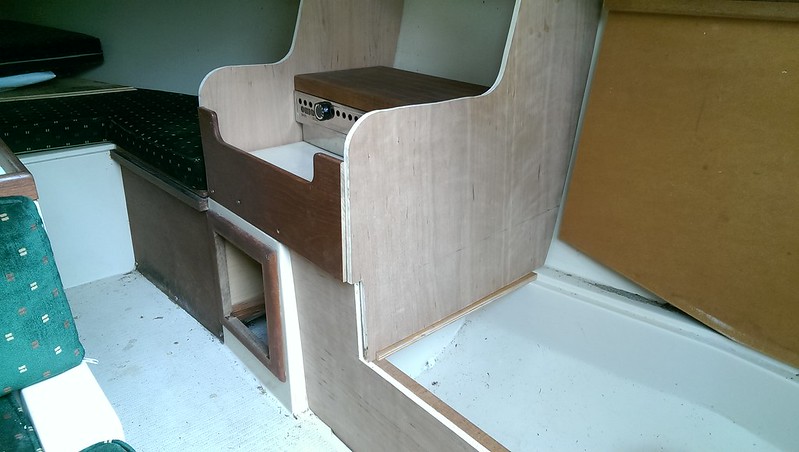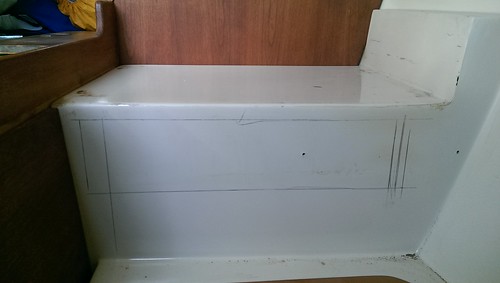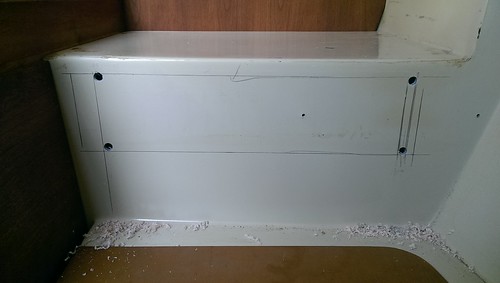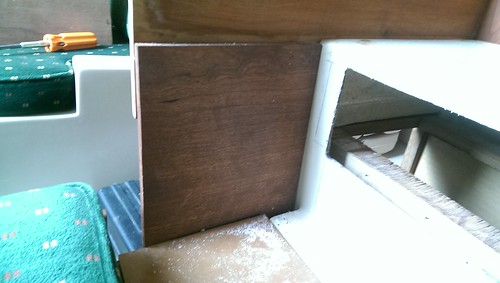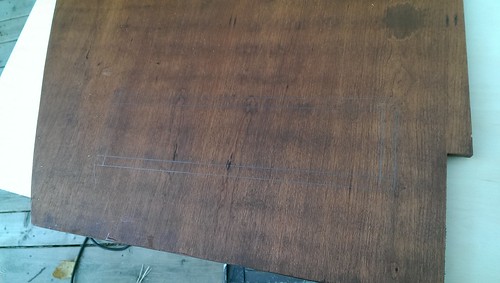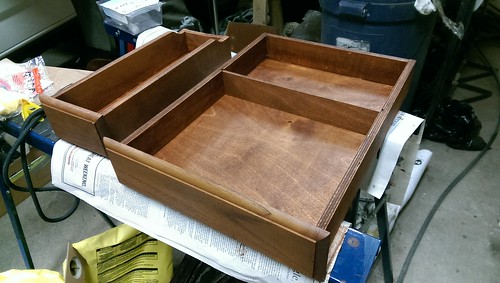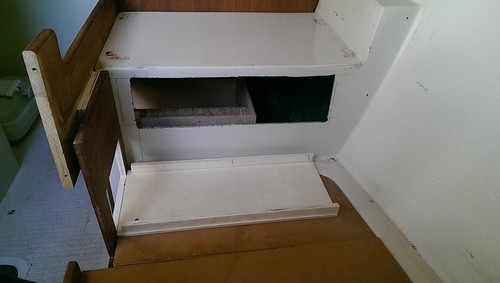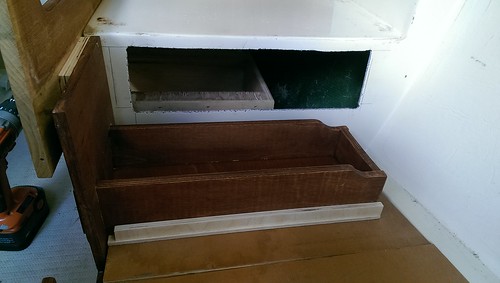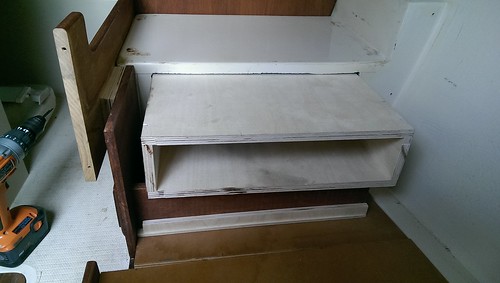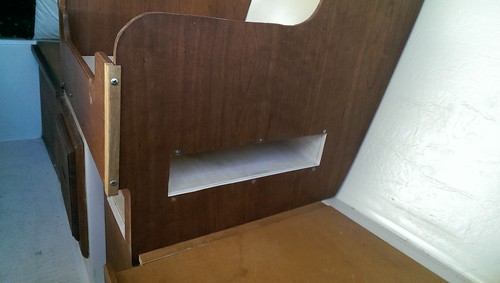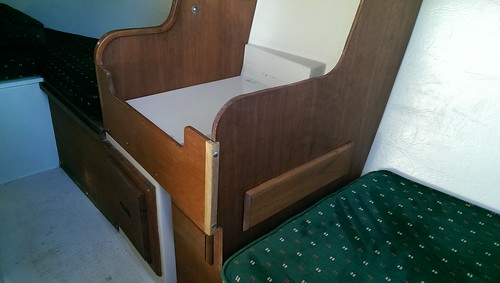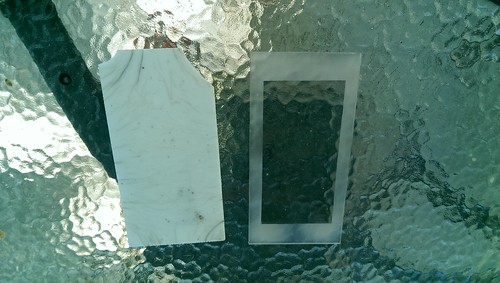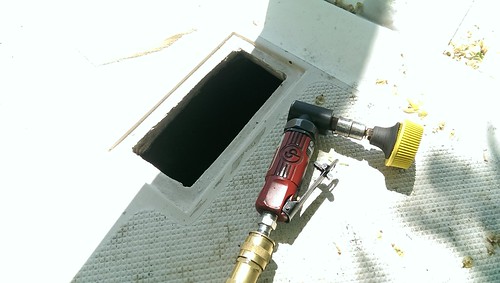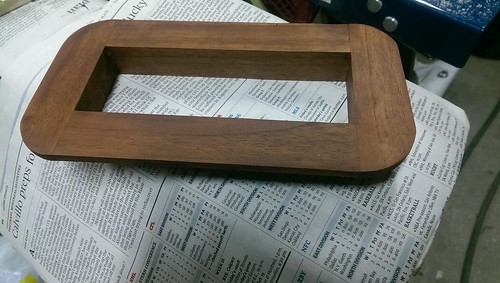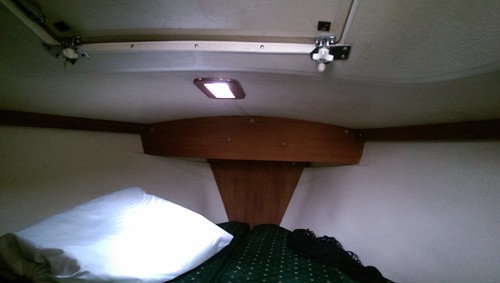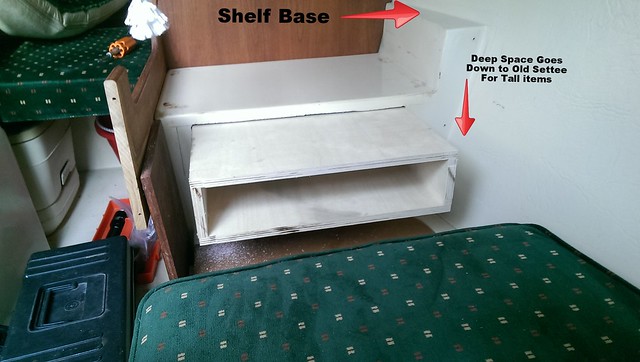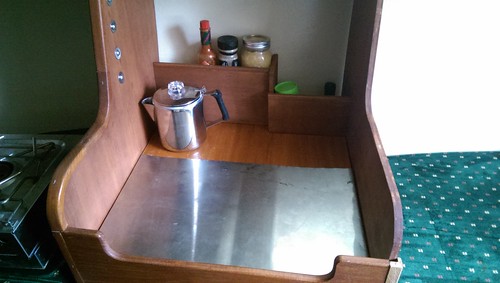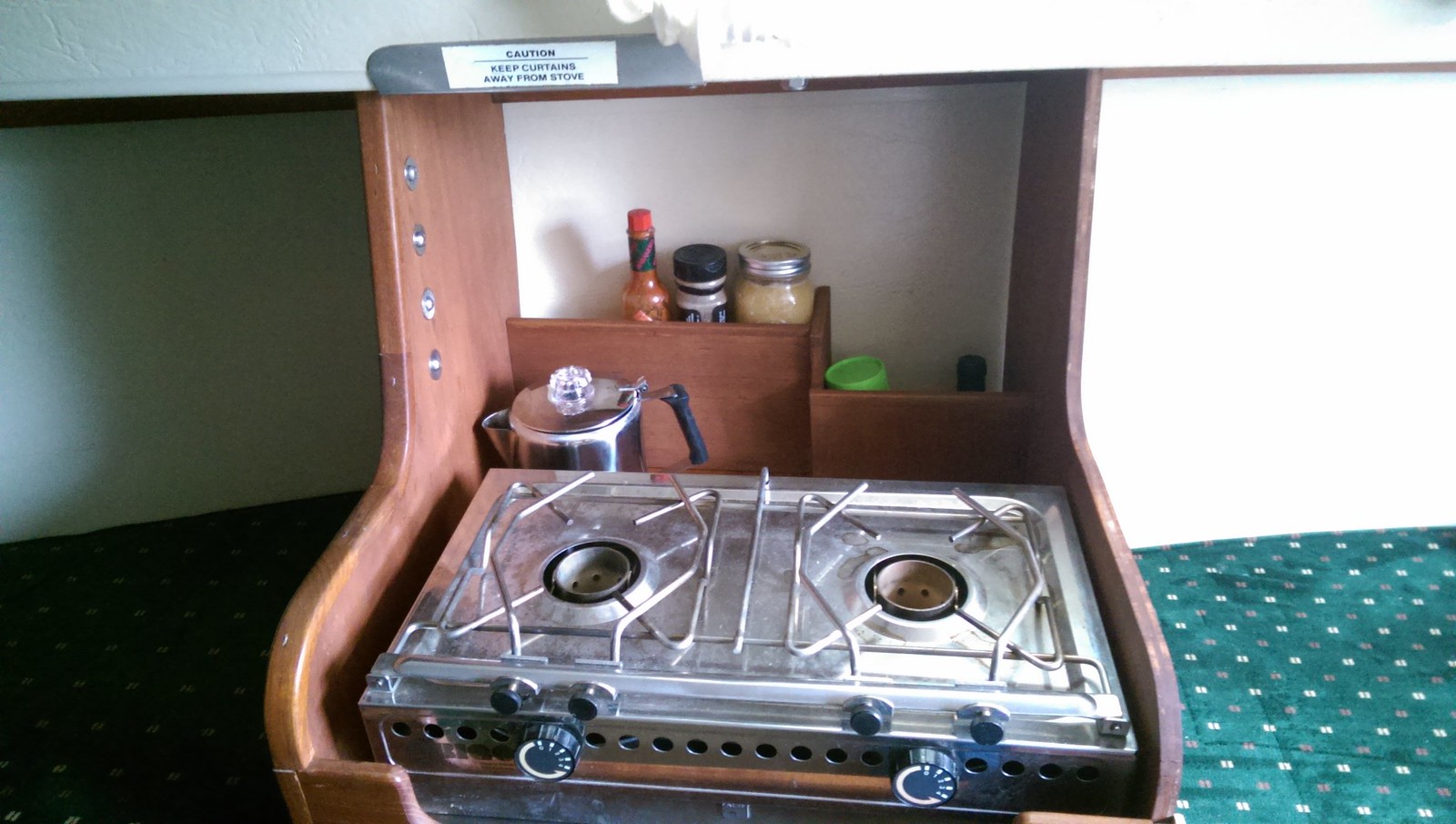---------------
Houston, We have Liftoff....
---------------
Well... on Saturday the boat finally hit the water for the first time under our ownership.
The marina/harbour is small, but as expected the launch works well for the Catalina 22.
As I mentioned before, there is an early C22 berthed there. (Only other sailboat was a MacGregor 26)
Unfortunately the launch ramp doesn't have a dock right beside it. Having one makes boat launching simpler.
This harbour is on a straight section of shoreline, but the space is fairly tight in strong winds.
There is a stone breakwater to help block the wind and waves but it is by no means sheltered.
When launching we had Force 5 winds (approx 15 to 20 knts) outside the breakwater.
Compared to the small fishing boats there, the C22 is affected by windage a fair amount.
In this case, while my wife was pulling the truck+trailer off the ramp, I had to lower the rudder, lower the keel if possible, and quickly get the boat moving so I could steer her and keep the wind from blowing her onto the docks.
We rigged the boat, and quickly tested the outboard to ensure it would start immediately.
When on the ramp, the boat would have the wind blowing on the starboard bow,
We chose a dock that we wanted to tie up to. There were a few empty berths, so I chose one that would allow me to have fenders on the port side. Having never had the boat in the water, I was worried about how it handled. By having the fenders on the port side, I also had the backup option of putting the boat into the slip which was in the channel directly behind the ramp.
With the fenders out, docklines ready, and 3 hours of daylight left, we crossed our fingers.
The launch itself was easy. There's a good drop-off just into the water, so the boat was floating before the truck axle was in the water. I backed into position, then jumped into the bed of the truck. My wife then backed up until the boat was floating. She then got out and held the bowline, while I climbed off the pickup's lowered tailgate, over the bow, and into the boat.
I fired up the outboard and my wife released the bowline.
I had hoped that the keel, even though it was up, would give good directional control.
I had planned to use the rudder and outboard to pull the stern to port, and once I had room, motor forward to get the bow through the wind, and motor to the berth.
Nope... nothing doing.
As expected, the boat drifted sideways, until the rudder was down, which then caused the bow to fall off the wind.
But even with the boat moving astern, the bow still wanted to fall off more than I expected.
Being unsure of the boat's abilities, I wasn't comfortable in the remaining space I had, to simply crank the throttle forward to get the bow around.
Very quickly, the boat was going to be laying perpendicular to the channel, instead of "in" it.
I quickly changed plans aka panicked aka became very focused.
I had no idea how deep the water was, but I QUICKLY dropped the keel a couple cranks, shoved both the rudder and outboard over more and give it full throttle in reverse. Once I knew I was going to clear the dock beside the channel, and the bow was coming over, I threw both tillers over the other way and cranked the throttle forward to slow the boat down, then throttled back.
I was able to throw a dockline over a cleat, and it pulled the boat pulled to the dock.
Once tied to the dock, I waited for my wife to come back from parking the trailer+truck. We fired up the stove for tea, and I considered changing my shorts.
While it worked out ok. I absolutely HATE being surprised.
I'm used to sailing dinghy's and large keelboats. (this is my first experience with something in the middle)
Every time I've sailed an unfamiliar boat, I do some figure eights out on the water, to get a feel for how it handles.
If there are empty berths I'll use them to see how the boat handles. How much prop walk ? How well does she handle going astern ?
It goes a long way to help things the first time you pick up a mooring ball, or pull into a crowded dock.
The C22 is a lighter boat than a normal keelboat, so it would obviously be pushed around easier.
I had considered having my wife, use the line to help pull the bow through the wind, and help keep the boat in full control.
In hindsight I could have tackled it differently in other ways.
A word of advice.. One which I usually heed. Don't rush... Even if the sun is going down and you desperately want to have your boat in the water.
And of course.... As soon as the boat was tied to the dock, the wind died down with the coming sunset. hehe
------------
Last few things on the checklist before departure.
------------
Now that the boat was in the water, and kettle was on for tea, I proceeded to check the last few things on my "Is that ok ?" list.
I fired up the VHF and did a radio check with the coast guard station. Working great !
I fired up the Signet Smartpak depth finder/log to see if it's getting a signal. Nope.. I suspected that, but now I know for sure.
Great ! Now to do some sailing.
Ever see that Berlitz Ad.. where the the German Coastguard guy says.. "Vat.. Are you sinking.. abowt ?"
Final result: We aren't getting to sail the boat this year.
Yeah spartacus99.. you can laugh.. :-D
It's "All Good" though... I can't say we're not disappointed, but we got a lot done, and we now know exactly what condition she is in, and have added the last few things to the project list

The launch ramp


"Hyacinth ! I SAY... is the tea brewed yet ? The boat won't float all day. Keep Calm and Carry On !"
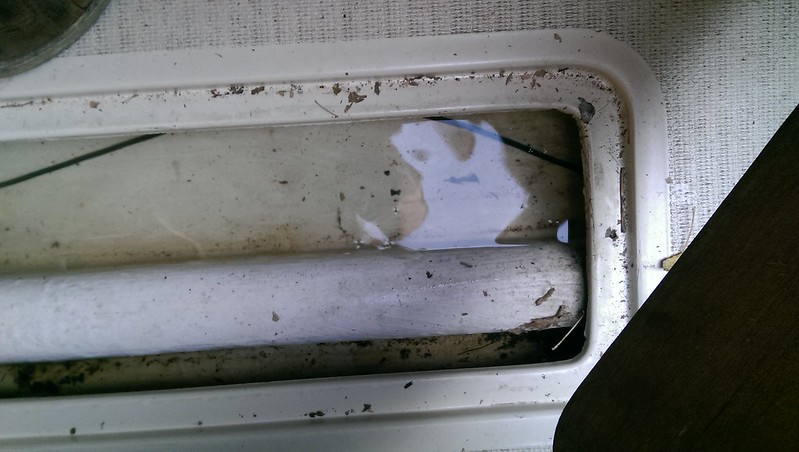
Houston, We have Liftoff....
---------------
Well... on Saturday the boat finally hit the water for the first time under our ownership.
The marina/harbour is small, but as expected the launch works well for the Catalina 22.
As I mentioned before, there is an early C22 berthed there. (Only other sailboat was a MacGregor 26)
Unfortunately the launch ramp doesn't have a dock right beside it. Having one makes boat launching simpler.
This harbour is on a straight section of shoreline, but the space is fairly tight in strong winds.
There is a stone breakwater to help block the wind and waves but it is by no means sheltered.
When launching we had Force 5 winds (approx 15 to 20 knts) outside the breakwater.
Compared to the small fishing boats there, the C22 is affected by windage a fair amount.
In this case, while my wife was pulling the truck+trailer off the ramp, I had to lower the rudder, lower the keel if possible, and quickly get the boat moving so I could steer her and keep the wind from blowing her onto the docks.
We rigged the boat, and quickly tested the outboard to ensure it would start immediately.
When on the ramp, the boat would have the wind blowing on the starboard bow,
We chose a dock that we wanted to tie up to. There were a few empty berths, so I chose one that would allow me to have fenders on the port side. Having never had the boat in the water, I was worried about how it handled. By having the fenders on the port side, I also had the backup option of putting the boat into the slip which was in the channel directly behind the ramp.
With the fenders out, docklines ready, and 3 hours of daylight left, we crossed our fingers.
The launch itself was easy. There's a good drop-off just into the water, so the boat was floating before the truck axle was in the water. I backed into position, then jumped into the bed of the truck. My wife then backed up until the boat was floating. She then got out and held the bowline, while I climbed off the pickup's lowered tailgate, over the bow, and into the boat.
I fired up the outboard and my wife released the bowline.
I had hoped that the keel, even though it was up, would give good directional control.
I had planned to use the rudder and outboard to pull the stern to port, and once I had room, motor forward to get the bow through the wind, and motor to the berth.
Nope... nothing doing.
As expected, the boat drifted sideways, until the rudder was down, which then caused the bow to fall off the wind.
But even with the boat moving astern, the bow still wanted to fall off more than I expected.
Being unsure of the boat's abilities, I wasn't comfortable in the remaining space I had, to simply crank the throttle forward to get the bow around.
Very quickly, the boat was going to be laying perpendicular to the channel, instead of "in" it.
I quickly changed plans aka panicked aka became very focused.
I had no idea how deep the water was, but I QUICKLY dropped the keel a couple cranks, shoved both the rudder and outboard over more and give it full throttle in reverse. Once I knew I was going to clear the dock beside the channel, and the bow was coming over, I threw both tillers over the other way and cranked the throttle forward to slow the boat down, then throttled back.
I was able to throw a dockline over a cleat, and it pulled the boat pulled to the dock.
Once tied to the dock, I waited for my wife to come back from parking the trailer+truck. We fired up the stove for tea, and I considered changing my shorts.
While it worked out ok. I absolutely HATE being surprised.
I'm used to sailing dinghy's and large keelboats. (this is my first experience with something in the middle)
Every time I've sailed an unfamiliar boat, I do some figure eights out on the water, to get a feel for how it handles.
If there are empty berths I'll use them to see how the boat handles. How much prop walk ? How well does she handle going astern ?
It goes a long way to help things the first time you pick up a mooring ball, or pull into a crowded dock.
The C22 is a lighter boat than a normal keelboat, so it would obviously be pushed around easier.
I had considered having my wife, use the line to help pull the bow through the wind, and help keep the boat in full control.
In hindsight I could have tackled it differently in other ways.
A word of advice.. One which I usually heed. Don't rush... Even if the sun is going down and you desperately want to have your boat in the water.
And of course.... As soon as the boat was tied to the dock, the wind died down with the coming sunset. hehe
------------
Last few things on the checklist before departure.
------------
Now that the boat was in the water, and kettle was on for tea, I proceeded to check the last few things on my "Is that ok ?" list.
I fired up the VHF and did a radio check with the coast guard station. Working great !
I fired up the Signet Smartpak depth finder/log to see if it's getting a signal. Nope.. I suspected that, but now I know for sure.
Great ! Now to do some sailing.
Me: "It's getting late. We don't have time to sail today, and get the boat back on the trailer."
Mate: "What if we leave the boat in the marina for a few days, and come back and sail on Monday ?"
Me: "That might work. We'll have to check the forecast"
Me: "At the very least we should head out onto the lake for a few minutes !"
Me: " Hey... do me a favour and pull that cabin sole access panel up, we have to check one more thing......"
Ever see that Berlitz Ad.. where the the German Coastguard guy says.. "Vat.. Are you sinking.. abowt ?"
Mate: "There's water in there"
Me: "It may just be rain from the darn pop-top seal leak.... Let's check to see where it's coming from"
Me: After pulling the cooler out of the way.. "Oh Oh... The depth finder transducer is leaking... In fact it's leaking fairly fast... I don't think we have time to finish our tea, never mind take the boat out on the lake for 20 minutes... I'll go get the truck..."
Final result: We aren't getting to sail the boat this year.
Yeah spartacus99.. you can laugh.. :-D
It's "All Good" though... I can't say we're not disappointed, but we got a lot done, and we now know exactly what condition she is in, and have added the last few things to the project list
- The furling drum needs to be moved higher to allow easier rigging
- Streamline the mast crutch so that backstay doesn't get caught when raising mast.
- Put more air in the fenders
- Replace the bow eye safety chain on the trailer
- Speaking of that... any suggestions for instruments ?

The launch ramp


"Hyacinth ! I SAY... is the tea brewed yet ? The boat won't float all day. Keep Calm and Carry On !"

Last edited:



